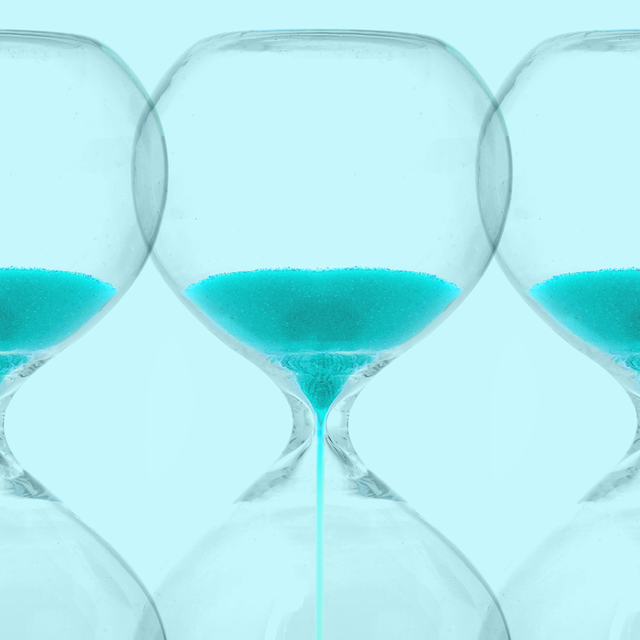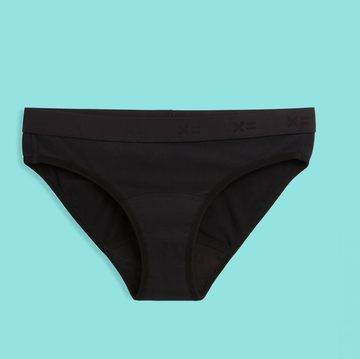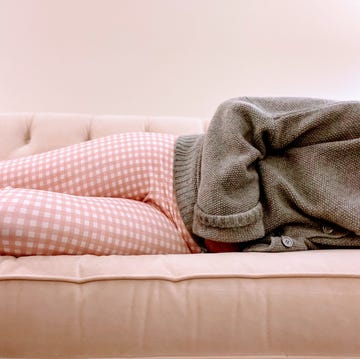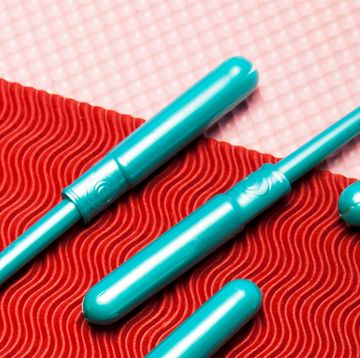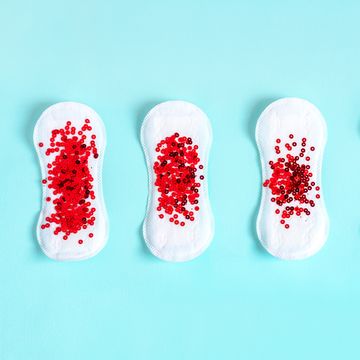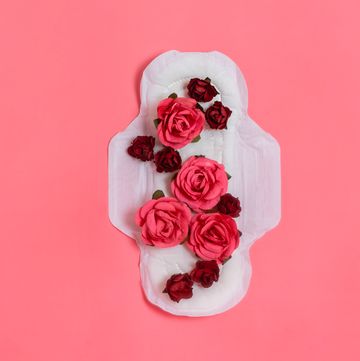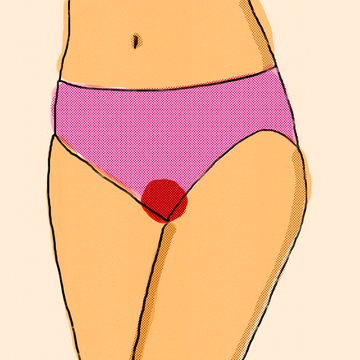“Each month, it feels like my body is fighting against itself and fighting against my career,” says Laken Brooks, a grad student who has endured painful, debilitating periods since she was ten years old. Brooks, who has endometriosis, checks her banking app each month when her period arrives to see if she can afford to take a day off from work. “I don't get paid for the time I miss, so I've had to judge if I want a day of respite to recover or if I want to be able to afford my medicine and groceries for the week.” Brooks says that if she could have paid time off for her period, she “wouldn't have to choose between my wellness and my timesheet.”
As Brooks and so many others know all too well, period pain can be real — and it's no joke. At its worst, it has been described as comparable to second-stage labor or the equivalent of cutting off your finger without anesthetic by OB/GYN and pain medicine physician Dr. Jen Gunter. Some 85% of women experience painful cramps, and 73% report gastrointestinal symptoms. Among women who suffer migraines, 60 to 70% say they occur during their periods. Some 7 out of 10 women reported fatigue during menstruation, and nearly 8 out of 10 said their periods caused psychological distress, according to a 2017 survey of almost 43,000 women. Nearly 4 out of 10 of the women surveyed said their period symptoms made them unable to perform all of their regular activities.
Given that there’s no U.S. law requiring sick leave or family leave, the idea of federally required paid menstrual leave may seem improbable. Some Asian and African countries offer period leave, but it’s often unpaid — and rooted in sexism. Rather than trusting people who menstruate to take the time off they need, many of these policies can feel condescending. For example, the burden is often put on the person experiencing period pain to “prove” time off is really necessary, with some employers requiring doctors’ notes or invasive physical exams before greenlighting the leave. World wars inspired Russia and Japan to provide menstrual leave in a bid to remove women from the workforce and repopulate society, but just because period time off has sexist origins doesn’t mean it can't exist in a progressive, non-patriarchal way.
Some businesses already do offer paid period time off
Last year, the city of Girona, Spain approved up to eight hours of monthly menstrual leave (though the time off must be made up within three months). Meanwhile, Australian period underwear company, Modibodi, Canadian menstrual cup brand Diva Cup and Indian food delivery service Zomato all offer paid period time off, despite no federally mandated policy. They’ve also managed to do so without any sexist fine print, and some U.S. brands are following suit. Offering paid period time off lets menstruating workers rest rather than push past pain. This ultimately results in increased productivity and a boost in morale, some U.S. business owners say.
Anastasia Allmon, a personal injury lawyer, never meant to spark a three-days-a-month paid period leave policy at her law firm. But after her boss overheard her and her coworkers discussing period pain at a Christmas office party, “he seemed genuinely interested and like he wanted to find a way to support us.” While paid period time off was never discussed, Allmon says her boss must have researched it over the weekend, because suddenly it was official company policy.
“I can’t tell you how incredible it’s been,” Allmon says. Though she notes there’s been grumbling from some of her male coworkers and "even some women who seem to consider themselves better for not taking the time," for her, it’s been a relief. Allmon suffers from painful cramps and likes having the option to work from home when they’re particularly bad. But on days she chooses to work in the office on her period, “it’s such a comfort to know that I can dip out of work if necessary.”
When a female friend revealed to him how excruciating her periods can be, Adam Garcia, owner of The Stock Dork, decided to create a paid menstrual leave policy for his company. In defiance of business owners who say that offering paid period time off is too expensive, Garcia says that in the midst of the Great Resignation, offering “perks” are important. Paid menstrual leave, he says, is far more worthwhile — and less expensive — than “splurging on PS4 rooms or gift cards and subscription boxes.”
Providing sick pay, for example, costs employers an average of 45 cents per hour per employee, which amounts to $3.60 a day. Using that calculation, it would cost just over $43 a year per person to take one day of paid period leave per month. Yet according to a 2017 survey of 600 Americans, nearly half thought that if the U.S. were to offer menstrual leave, it would have negative consequences. Recurring worries ranged from basic sexism ("just deal with your pain!") to whining ("but what about cis men being left out?"). If parity existed, the “special treatment” argument might have some validity. But in a world where equality does not exist, and where women are paid 82 cents for every dollar earned by men, I can't help but wonder why people who menstruate should work through pain just because it’s been deemed the norm.
Period leave may have unintended consequences
Some argue that paid period leave makes women look weak and that it will result in less women being hired and take us further away from true equality. Back in 2016, Bex Baxter made international headlines when she initiated a flexible time off menstrual work policy at Coexist in the UK. The most stinging comment, she revealed in a 2017 TEDx talk, was that she was rolling feminism back by 100 years. Feminists who had pushed past period pain in order to accommodate a work environment designed for men were outraged: How could anyone go out of their way to highlight something they had fought for years to hide?
But pretending period pain doesn’t exist is not the route to gender equality, says Courtney King, co-founder of gender-inclusive period tracking app Orchyd. They believe “normalizing menstruation and the discussion around period pain is more important than prioritizing antiquated thoughts about gender in the workplace.” Melissa Berton, who won an Academy Award for her 2019 documentary, Period. End of Sentence, agrees. “There is something anti-feminist in not acknowledging a woman's body in its full scope,” she says.
Ideally, paid menstrual leave would prevail without backlash, adds lawyer Jennifer Weiss-Wolf, the co-founder of Period Equity and the author of Periods Gone Public. “But I would absolutely worry that some of what's been observed about menstrual leave in other countries would take on new ways to marginalize and undermine people in the workplace.”
In Indonesia, where offering two days of period leave a month is required by law but payment is not mandatory, people with periods have to submit to a physical examination to prove they’re really bleeding. Likely as a result, few workers use the benefit. Some feminists worried about repercussions from paid period leave, say that if someone's period pain is severe enough to require time off work, they should take birth control to eliminate period symptoms. But while considered safe for most users, birth control is not without side effects, and certain medical conditions can increase risks.
Menstruation leave would be life-changing for many
Hairdresser Eileena Nunes first started passing out due to excessive blood loss during her menstrual cycle in high school. As an adult, she ended up in the hospital with iron levels so low her doctor suggested a blood transfusion. But her mental health suffered and her hair fell out when she took birth control pills to stop her period, so she began taking high-dose liquid iron instead and has been patiently waiting for menopause to start for years.
“Pregnant hairdressers don't even have the chance to have time off to have their babies,” Nunes says, “because they still have to pay their booth rent.” If Nunes had paid menstrual leave, it would be revolutionary, she says. She could take time off for her periods and wouldn’t have to stand 12 hours a day, sometimes getting right back up on her feet mere minutes after fainting.
Painful though it may be, I believe talking about our periods is the only way forward — but it may take time for workers to get used to. When Davielle Jackson, CEO of period underwear company Femi Secrets sent out a company-wide memo announcing a new paid menstrual leave policy, no one replied. “What started to happen was our employees came to me personally and would say, ‘Hey, I just want to thank you so much for what you did.’” Jackson says that as the head of a company that is loud and proud about periods, she was shocked that her employees only wanted to talk about paid period leave behind closed doors — and that she had to nudge them to actually take advantage of it. Three months passed before a single employee requested the time.
Statistically, though, that checks out. In 2018, U.S. workers took an average of 2.5 sick days. On average, two thirds of available sick days go unused. Given the stigma around the subject, it bears out that employees would be highly unlikely to abuse paid menstrual leave, despite fears to the contrary. Jackson is hopeful that more business owners will follow her lead by implementing paid period time off. She has seen firsthand that when we stop white knuckling through pain, productivity increases.
The instinct to “fight through any symptom and say, ‘Anything you can do, I can do bleeding,’” is a remnant of old-school feminism, says Kim Rosas, a menstrual educator. “At some point, you have to recognize that maybe it didn't have to be that way to begin with.”

Brijana Prooker is a Los Angeles-based freelance journalist and mom to two peanut butter-colored rescue girls (a pit bull named Ivy and kitty named Doosis). In addition to Good Housekeeping, her bylines include ELLE, Bitch Media and Washington Post’s The Lily.
